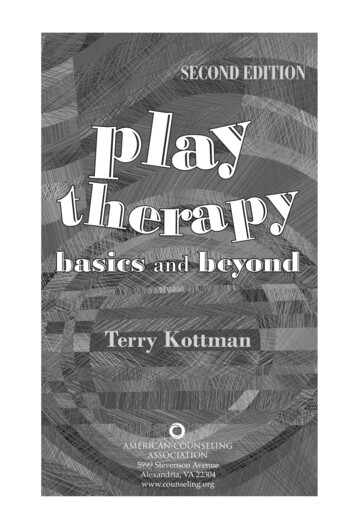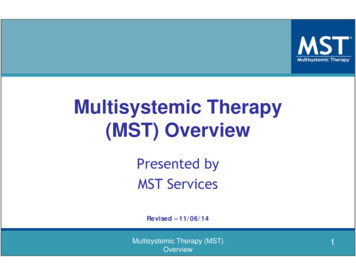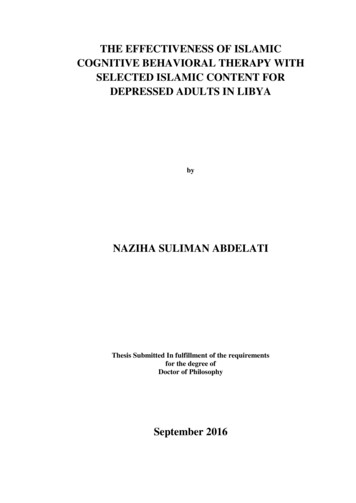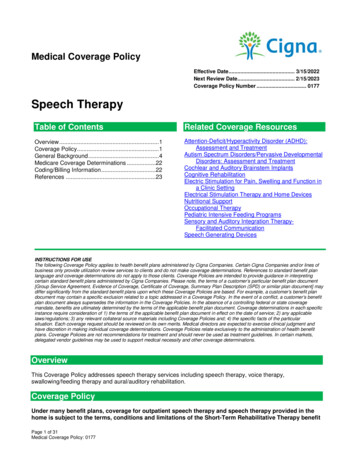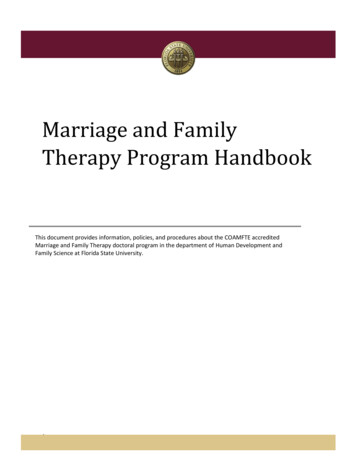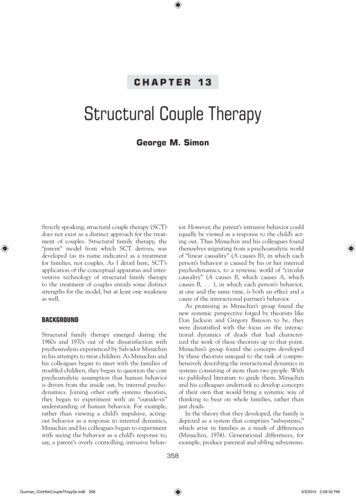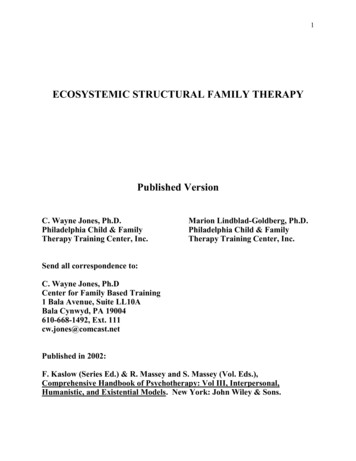
Transcription
1ECOSYSTEMIC STRUCTURAL FAMILY THERAPYPublished VersionC. Wayne Jones, Ph.D.Philadelphia Child & FamilyTherapy Training Center, Inc.Marion Lindblad-Goldberg, Ph.D.Philadelphia Child & FamilyTherapy Training Center, Inc.Send all correspondence to:C. Wayne Jones, Ph.DCenter for Family Based Training1 Bala Avenue, Suite LL10ABala Cynwyd, PA 19004610-668-1492, Ext. 111cw.jones@comcast.netPublished in 2002:F. Kaslow (Series Ed.) & R. Massey and S. Massey (Vol. Eds.),Comprehensive Handbook of Psychotherapy: Vol III, Interpersonal,Humanistic, and Existential Models. New York: John Wiley & Sons.
2Ecosystemic Structural Family Therapy: An Elaboration of Theory and PracticeHistory of Therapeutic ApproachEarly FoundationsThe earliest published version of the highly pragmatic Structural Family Therapy (SFT) modelappeared on the psychotherapy landscape in 1967 (Minuchin, Montalvo, Guerney, Rosman, & Schumer).The model was further elaborated in 1974 (Minuchin), 1978 (Minuchin, Rosman, & Baker), 1981(Minuchin & Fishman), 1989 (Elizur & Minuchin), and 1993 (Minuchin & Nichols; Fishman). WhileSalvador Minuchin, the primary exponent of SFT, preferred the language of organization and role theoryin describing this theoretical model, his conceptual thinking was influenced by his colleague Jay Haleyand others who were well-versed in communication and systemic theories (e.g. Bateson, 1979; Haley,1963; Jackson, 1957; Watzlawick, Jackson, & Beavin, 1967). Minuchin, known as much for his dramaticand compelling therapeutic style as for his theory development, credited both Nathan Ackerman’spassionate clinical work and Braulio Montalvo’s clinical complexity and sensitivity for his inspiration asa clinician (Minuchin, 1985; Nichols & Schwartz, 1998).Minuchin, Montalvo, and Haley collaborated in the early development of what became known asStructural Family Therapy. Haley, however, eventually developed his own therapeutic model termed“Problem-Solving Therapy,” which emphasized a narrower focus on symptoms. Both therapy modelshighlight the importance of reconfiguring non-adaptive family coalitions and tie theory to a familydevelopmental framework (Minuchin, 1974; Haley, 1976). Minuchin’s life experiences, his longstandingcommitment to working with low-income, multi-problem families, and his collaborative relationship withE. H. Auerswald (1968) sensitized him to examine a family’s ecology. An ecological approach involvesgiving attention to the total field of a problem, including extended family, friends, other professionals,community agencies, and institutions. For more detailed description of the historical origins of StructuralFamily Therapy see Colapinto (1991), Minuchin and Nichols (1993), or Nichols and Schwartz (1998).In this model, Minuchin directed clinical attention to the recurring, often enduring, patterns ofinteraction which come to organize and structure daily family life. This meant that understanding problemformation, problem maintenance, and change in the treatment of children and adolescents could be foundwithin an analysis or “mapping” of family structure. Since core relational patterns are revealed primarilyduring family interactions, the hallmark of practice within this model has been its here-and-now, actionorientation to helping. In the SFT model, therapists work from within a family system. They connectwith and learn about the uniqueness of the family and its members, as well as facilitate and supportchange, by creating or capitalizing on natural emotional and relational challenges within ongoinginteraction. In vivo learning through the use of in-session enactments is one of SFT’s distinctivecontributions to family therapy (Simon, 1995; Diamond & Liddle, 1999).
3These foundational elements of the model remain solid and intact in the contemporary theory andpractice of SFT. However, like the entire child-and-family-therapy field, the model has undergoneconsiderable development and refinement over the last thirty years, stimulated by advances in theory andresearch from many fields. One major set of influences on current SFT practice has been findings fromtreatment studies that have examined the major constructs of the model and the mechanisms of change asapplied to specific clinical populations. These studies utilize integrative models which were derived fromclassic SFT and include Multi-Dimensional Family Therapy (MDFT; Liddle, 2000), Attachment-BasedFamily Therapy (ABFT; Diamond, Diamond, & Siqueland, in press), Multi-Systemic Family Therapy(MST; Henggeler, Schoenwald, Borduin, Rowland, & Cunningham, 1998) and the Bio-BehavioralFamily Model (BBFM; Wood, Kleba, & Milller, 2000). Other influences stem from empirical andconceptual advances in developmental science and developmental psychopathology (e.g. Cicchetti, Toth,& Lynch, 1995; Greenspan, 1992; Sameroff & Emde, 1989; Siegal, 1999; Sroufe, 1997) and familypsychology (e.g. Gottman, Katz, & Hooven, 1997). SFT continues to be a highly popular model amongclinicians, in part because of its reputation for effectiveness, conceptual clarity, strong training programs,and a capacity for incorporating new ideas and research advances over time.Recent ElaborationsMuch of the updating of SFT theory and practice described in this chapter has evolved within thePhiladelphia Child and Family Therapy Training Center, Inc., as well as from staff within its formerparent organizations, the Philadelphia Child Guidance Center and the Children’s Hospital of Philadelphia.The model, as currently practiced and taught by the authors, has changed in three major ways.First, the array of information considered important for deciding on goal setting, treatmentplanning and treatment implementation has significantly broadened. Data regarding individual biological,developmental, affective, and psychological processes are as likely to be included in the thinking thatgoes into case formulations as is information about family- and larger-system processes. Originally, in afirst interview, therapists were encouraged to focus narrowly on the assessment of family interactionalpatterns in relationship to a child’s symptoms, and then be prepared to implement immediate changeproducing strategies in the session. This confined therapists to here-and-now interactional data, whichoften contributed to underdeveloped pictures of the child or the family in either historical context or alarger community context. Having been influenced by best-practice standards emerging in the publicmental-health arena, SFT therapists are encouraged to obtain a comprehensive bio-psychosocialassessment of a child or adolescent within relevant social contexts at both the macro and micro levels(Engels, 1980)Second, the posture toward the therapist-child-family relationship has shifted toward one ofgreater collaboration and partnership, building upon the model’s historical strengths-based approach. Asin many of the classic models of family therapy, the therapist‘s role in early SFT highlighted the
4therapist’s expertise, setting up a clear hierarchical position vis-à-vis the family. Today, practitioners ofSFT directly recognize and capitalize on the respective expertise and resources of a family, child, oradolescent, other involved helpers, as well as themselves. Families, and often the focus child oradolescent, are fully and actively involved in the planning of assessment and treatment, as well as in theevaluation of treatment outcomes (Hodas, 1997).Third, emotions and emotional development in the family receive increased focus. Particularattention is given to family styles of regulating or soothing the strong affective states of members (familyemotion regulation) and to family members’ subjective internal experience of emotional connection andattachment (affective proximity). Building relationships in a family, as well in other social settings,which will promote and nurture the development of specific social-emotional competencies has assumeda central role in the current theory and practice of SFT. This goal has become a critical anchor forshaping the types of assessments and interventions used.Minuchin (1974) highlighted the importance of preparing children to navigate their worldscompetently in his early articulation of principles regarding family functioning, but the individual skillsnecessary for this remained vague and were rarely targeted for direct change. In part, this occurredbecause, until recently, not much certainty existed in the developmental field as to the nature of theseskills. Now a large body of work is devoted to identifying key social-emotional skills (Mayer & Salovey,1993), understanding the internal processes and milestones in their development (Greenspan, 1992;Denham, 1998), and specifying parenting practices or family processes which promote or constrain theirdevelopment (Saarni, 1999; Gottman, et al., 1996).A focus on an individual child’s social-emotional development necessitates a broadening of theoverarching goals of therapy. In the earliest versions of the model, therapy was considered successfulwhen symptoms were resolved and the family was assumed to be more “functional.” Functionality wasbroadly defined as the fit between the demands confronting the child and family and the organizationalstructure in place to meet these demands. While this concept remains very useful, it has lacked a clearreferent to the developmental literature and current thinking about what constitutes “healthy” socialemotional functioning and the vast array of individual differences among children and adolescentsimpacting both developmental outcomes and family functioning. A strict focus on organizationalfunctionality as a treatment outcome risks placing too much value on form over meaning.Contemporary SFT involves focusing on growth-promoting practices and the strength ofemotional connections. This captures specific dynamic, fluid processes at work in families and othersystems that are directly tied to child outcomes. Assessment and treatment are anchored firmly indevelopmental theory. This allows for a more evenly dispersed emphasis between the short-term clinicalgoals of symptom relief and family change, and the long-term preventive goals of growth anddevelopment. This signifies fostering change at multiple system levels, including the individual child, the
5family, and the child-family-community interface. The current overarching goals of SFT are now definedas: To resolve presenting problems and to eliminate negative interaction cycles; To shift the developmental trajectories of children, such that they are moving toward greatercapacity for self-regulation and social-emotional competence; To enable a family to organize and emotionally connect in such a way that they become moregrowth-promoting in their interactions with one another; and To enable relevant community systems to organize in such a way that a family’s efforts towardcreating a growth-promoting context is nurtured.Theoretical Constructs and PrinciplesContemporary SFT embraces an appreciation that the structure and dynamics of familyrelationships are strongly shaped by forces within the broader social context, such as culture, race, gender,politics, and economics (McGoldrick, 1998). However, the specific relationship adaptations that resultfrom these and other influences constitute both the primary target and locus of change in the SFT model.Four major theoretical constructs guide therapists in determining the focus of observations and change inparticular family relationships: family structure, family emotion regulation, individual differences, andfamily development.Identifying structural patterns informs therapists about what family members are expecting fromand doing with one another. This provides a snapshot of interactional sequences promoting orconstraining mastery of specific challenges. Family emotion regulation shows therapists the emotionalmeaning embedded in these interactions and how members help one another to handle emotional distress.Therapists observe the specific types of family interactions around family member’s emotionalexperiences which need strengthening in order to support the development of children’s social-emotionalcompetencies. Recognition of individual differences within the family help a therapist attune to uniqueneeds (e.g. temperament, learning styles, vulnerabilities to emotional disorders) and histories (e.g. trauma)requiring adjustments of approach, timing, and pacing of change. A focus on family developmentenables therapists to understand the specific emotional challenges being faced by a child and family asthey move through time within a particular cultural context.A basic assumptions in contemporary SFT, rooted in the developmental work of Fraiberg (1959)and White (1959), is that children enter the world wired to move forward and to adapt, despite the naturalchallenges and conflicts that come their ways. Likewise, families are presumed to be generally orientedtoward mastery and self-regulation, regardless of how poorly they may appear to be functioning at aparticular point in time. The orientation toward personal and family mastery remains a powerfulmotivating force and a key to understanding the strengths-based approach to treatment in SFT. Inpractice this implies that therapists must tap into this powerful, though often dormant, mastery orientation
6in order to help children and their families to become unstuck or to overcome barriers to moving towardgreater competency and adaptation.The four major interrelated constructs--family structure, family emotion regulation, individualdifferences, and family development--inform therapists about the multiple interacting forces supporting orconstraining children and their families’ movement toward greater mastery and development of coresocial-emotional competencies. These contemporary SFT constructs can be found within each of themajor integrative variants of the model (e.g. MDFT, ABFT, MST, and BBFM), albeit with differinglevels of emphasis and elaboration. These ideas guide assessment, intervention, and evaluation oftreatment outcomes.Family StructureFamilies serve both as major resources for children in mastering difficult emotional challengesand one of the major sources of these challenges. Families represent the matrix of identity development.From its earliest days, a fundamental premise guiding SFT is the “inextricable association of family andindividual: the family exists for the individual, the individual exists within the family” (Colapinto, 1991,p. 422). In order to understand children’s mastery efforts, therefore, it is important to construct a map ofa family regarding how challenges are most likely to be generated from within and their preferredpathways for helping children to negotiate challenges, whatever their sources.Over time, families tend to develop recurring, often enduring, patterns of interaction organizedaround the various day-to-day instrumental tasks and emotional challenges associated with livingtogether. These patterns have been designated “family structure,” a construct used to describe the mannerin which families organize themselves (Minuchin, 1974). These interactional patterns are set in motion byfamily-member expectations about how tasks, needs, and connections are to be managed. Over time andwith repetition, these interactions often become fixed presumptions that are prescriptive for maintainingfuture interactions. When similar patterns of interactions and expectations repeat themselves across avariety of family tasks and situations, they take on the status of core “rules” or “norms,” invisiblyregulating family-member behaviors and creating coherence.Family structure is comprised of both universal and idiosyncratic components. Universally, allfamilies have a hierarchical structure, and family members tend to have reciprocal and complementaryfunctions (Minuchin, 1974). Role complementarity or reciprocity refers to the degree family membersaccommodate to one another and to the level of rigidity or role exaggeration present. The idiosyncraticcomponent of family structure includes the mutual expectations of particular family members governinginteractions around daily routines, such as meals, sleep, work, recreation, intimacy, and homework. Thiscomponent of family structure is often strongly influenced by culture, particularly with respect to genderrole prescriptions.
7Families take many shapes and forms, including those which are single-parent, remarried, multigenerational, same-sex, or traditional. Regardless of form, all families tend to be differentiated intosubsystems of members who join together to perform various instrumental and emotional tasks, generallydetermined by generation, age, gender, nature of task, or common interests (Minuchin, 1974). Thesesubsystems include the individual, the couple, the parent(s), each parent-child dyad, the siblings, thegrandparents, the grandchildren, the relatives, or the non-biological kin. Each individual belongs to morethan one subsystem within a family. This can be a source of stress and strain when the demands of eachsubsystem are at odds or there are strong loyalty conflicts between different members. In growthpromoting families, each subsystem creates a context for learning a range of important life skills throughexperiencing different types of challenges, patterns of closeness and distance, emotional relationships,and levels of power. The particular family form or composition of family subsystems is far less importantthan how members organize along the two dimensions of family structure - - boundaries and affectiveproximity.Boundaries. Boundaries prove most critical for understanding the unique manner in whichfamilies actually function or regulate themselves within the organization they have created. Boundariesrefer to a family’s “rules defining who participates, and how” (Minuchin, 1974, p.53) in a giventransaction, i.e., who is in, who is out, and who is for or against. Boundaries help moderate bothinvolvement and hierarchy, thereby protecting the autonomy of the family and its subsystems.Boundaries are conceptualized along a continuum of permeability whose poles are the two extremes of“diffuse” and “rigid.”Wood (1985) distinguished between the boundaries separating physical or psychological spaceamong family members and boundaries dividing family roles. Role boundaries or “generationalhierarchy” clarify differentiation among responsibilities between generations, such as betweengrandparent, parent and child roles. A reversed generational boundary occurs when children parent theirparents and become responsible for controlling or taking care of them emotionally. A collapsedgenerational boundary refers to situations in which parents act as peers to their children or when crossgenerational alliances exist between a parent and their children against the other parent. The clarity andpermeability of role boundaries impacts how power is distributed within a family. Power describes “therelative influence of each [family] member on the outcome of an activity” (Aponte, 1976, p.434). Ingrowth-promoting families, the amount of status or power afforded to different family members orsubsystems is based primarily on their generational membership or developmental levels.Boundaries also refer to the amount of contact or involvement between individual familymembers, family subsystems, and with people or institutions outside the family – particularly with respectto carrying out specific tasks. In this sense, the concept of boundary is about physical or psychologicalspace, describing the amount of separation or distance between two or more personal domains of
8influence. Wood (1985) drew on Goffman’s (1971) list of physical and psychological territorialpreserves over which the individual has “entitlement to possess, control, use, or dispose of the object orstate in question” (p.28) to highlight six common areas of life around which family members tend toregularly negotiate. These territorial preserves include contact time, personal space, emotional space,information space, conversation space, and decision space.The family system or each subsystem can be described as excessively involved or under-involvedwith one another around some or all of these personal domains. Subsystems which are highly involvedand have highly permeable boundaries have been termed “enmeshed.” Individuals in enmeshedsubsystems function as if they are parts of each other. At the other end of the spectrum are subsystems inwhich individuals are minimally involved, show little interdependence and display a disengaged style. Atthe extremes, these types of relating can generate conditions for significant child and family problems.When adaptive mechanisms are evoked, an enmeshed family reacts to the slightest variation from theaccustomed routine whereas the disengaged family does not respond sufficiently when action isnecessary. Clear boundaries promote an optimal flow of contact and information between and withinsubsystems (Minuchin, 1974).Affective Proximity. Another important dimension of family structure, which represents a majorelaboration from earlier versions of SFT, revolves around the degree of affective proximity betweenfamily members. This concept describes family interactions associated with the subjective internalexperiences of emotional connection and attachment (Lindblad-Goldberg, Dore, & Stern, 1998). Incontrast to involvement, which captures the natural struggle in families between dependency andautonomy, the affective-proximity dimension of family structure refers to how secure family membersfeel in their relationships. This expanded concept--affective proximity--is based on Bowlby’s (1969,1988) perspective that security and emotional proximity are biologically based needs which driverelational behavior from the cradle to the grave. The attachment system is activated by conditions ofstress and perceived threat. Close and securely attached relationships occur when the people in arelationship feel they can count on one another to be attuned and responsive to distress signals.Attachment theory is increasingly recognized as critical in guiding treatment for a wide range ofclinical problems in families with children and adolescents (e.g. Byng-Hall; 1991; Marvin & Stewart,1990) as well as in adult couple relationships (Johnson, 1996). It is a core component within three of thefour major variants of SFT, including ABFT (Diamond et al, in press), MDFT (Liddle, 2000) and BBFM(Wood et al, 2000). Developmental research indicates considerable support for the central role played bysecurity of attachment in both psychological and behavioral outcomes (e.g. Cummings & Davies, 1996;Masten, Best, & Garmezy, 1990).Unlike involvement, which can be overwhelming and stunting when excessive, an emotionalconnection in a family can never be too secure. The processes of emotional involvement, as marked by
9boundaries, and emotional connection, as experienced in affective proximity, were often blurred togetherin earlier articulations of SFT, making it difficult to explain how relationships which were described asenmeshed could quickly transform into a system that looked disengaged. Involvement does notnecessarily predict the security of an emotional connection. For example, a mother and her 14-year-olddaughter appear to be highly enmeshed, with the mother involved in every aspect of her daughter’s life,yet at the same time they behave as though their emotional connection with one another is very fragile.This happens because the mother abruptly disengages and becomes critical when her daughter attemptsany autonomous action. When a child is taking the emotional risk of exploring new, more independentbehavior, they are both most vulnerable, yet at this point her mother leaves her stranded and alone. On theother hand, a husband and his wife appear to have low levels of involvement with one another, yet areclose because they both have faith that, if there were a crisis, the spouse would recognize it as such andrespond with support.Affective proximity calms and soothes the nervous system (Bowlby, 1988; Siegel, 1999),allowing other necessary instrumental and emotional tasks associated with being a family to be addressed.This proves essential for the development of emotion-regulation and other social-emotional competenciesin children. In the face of an inadequate, inconsistent, or ruptured emotional connection between familymembers, perceived distance can generate considerable distress and anxiety, setting in motion a range ofbehaviors designed to restore the relationship. The more family relationships are marked by highlynegative, rigidly repetitive interactions, the more likely a serious chronic disturbance with affectiveproximity exists. When attachments are insecure, family members become focused solely on theregulation and stabilization of their emotions and experience themselves as on the verge of beingoverwhelmed by absorbing negative emotional states (Johnson, 1996). Wynne’s (1984) epigeneticmodel of relationship development and Diamond and Liddle’s (1999) treatment-process research implythat family members must possess a fundamental basis for trust and attachment before they can have anyhope of learning communication skills, engaging in joint problem-solving, or developing intimacy.Family Emotion RegulationIn contemporary SFT, the processes in which emotions regulate and inform interaction amongfamily members and in turn generate emotional experiences and meaning for family members havebecome central in both case formulation and treatment implementation. This emphasis flows from theincreasing recognition from many disparate fields, including psychobiology (e.g. Siegel, 1999), thatemotion and its regulation form the core of internal and interpersonal processes shaping the organizationof self. With a model of emotions and emotional regulation within the family context, therapists canunderstand not only here-and-now interactions and the forces that fuel the evolution of various familystructures and the experiences of connection, but also fathom the forces shaping developmentaltrajectories of children. Empirical studies over the last 15 years from the integrative field of
10developmental science infer that emotional regulation plays a key role in the development of most majorchild-clinical problems (e.g. Cole, Michel, & O’Donnell, 1994; Cole & Zahn-Waxler, 1992; Malatesta &Wilson, 1988). For many clinical syndromes, such as disruptive behavior problems, anxiety, anddepression, the dysregulation of emotions in one or more emotional arenas (i.e. anger, fear, or sadness)provides the defining feature of the disorder.Emotion regulation, mediated in part by autonomic-nervous-system arousal processes, refers toan individual’s ability to manage subjective experiences of emotion, especially its intensity and duration,as well as the ability to handle strategically one’s expression or modulation of emotion in communicativecontexts (Faude, Jones, & Robins, 1996; Saarni, 1999). The press to maintain some subjective sense ofinternal organization and to avoid out-of-control, reactive behavior or a disorganized thought processinitiates a need for emotion regulation strategies, both at the individual and family-system levels. Theimpetus to retain some sense of emotional organization powerfully shapes emotional closeness anddistance in family relationships over time. In SFT today, family emotional regulation connotes theoverarching goal of all relationship systems to remain organized, emotionally connected, and emotionallybalanced.In earlier models of family therapy, the concept of homeostasis was utilized to describe how somefamilies seem to resist change, thus emphasizing the family’s need for stability and control (Hoffman,1981). This focus was confined to form (interactional organization) rather than meaning (emotionalorganization). Now the emphasis has shifted to the extent to which family members perceive theircapacities to regulate intensely felt negative emotions. In less adaptive families, fears that the family mayspiral into chaos and fragmentation often accompany poor ability to regulate negative emotions. Thisfrequently implies disconnection and isolation between family members. These fears become particularlypronounced when one or more family members have a history of trauma or a serious rupture of anattachment relationship has occurred. This leaves families with constricted, self-reinforcing relationshipcycles (Johnson & Williams-Keeler, 1998). Although emotional arousal is unavoidable and usuallydesirable, both families and their members must possess ways to modulate, tolerate, or endure theexperience of emotions which are perceived to be excessive (Denham, 1998). To some extent, howfamilies approach or avoid this task of emotion regulation gives each family system and each relationshipin it a unique shape and texture.Individual emotion regulation is influenced by temperament (Kagan, Reznick, & Snidman, 1988),by cognitive capacities or neurobiological conditions (Bradley, 2000), by patterns of caregiving infamilies (Calkins, 1994; Cassidy, 1994), and by a child’s access to coping resources, sometimes referredto as social-emotional competencies. Through a reciprocal developmental process, a child’s emotionalreactivity affects the ability to incorporate and construct higher-order social-emotional competencies. Inturn, a child’s social-emotional competencies affect the capacity to moderate intense emotions
11(Greenspan, 1992). A developmental model is based on the assumptions of a relatively predictableprogression in the growth of internal capacities which children bring to an interaction and that thesecapacities develop from the simple to the more complex. The core-component competencies associatedwith emotion-regulation predict the long-term rela
Ecosystemic Structural Family Therapy: An Elaboration of Theory and Practice History of Therapeutic Approach Early Foundations The earliest published version of the highly pragmatic Structural Family Therapy (SFT) model appeared on the psychotherapy landscape in 1967 (Minuchin, Montalvo, Guerney, Rosman, & Schumer).
